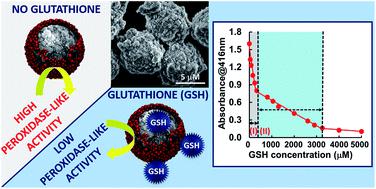当前位置:
X-MOL 学术
›
Anal. Methods
›
论文详情
Our official English website, www.x-mol.net, welcomes your
feedback! (Note: you will need to create a separate account there.)
Glutathione detection in human serum using gold nanoparticle decorated, monodisperse porous silica microspheres in the magnetic form
Analytical Methods ( IF 2.7 ) Pub Date : 2020-09-26 , DOI: 10.1039/d0ay01292k Burcu Gökçal 1 , Kadriye Özlem Hamaloğlu , Çiğdem Kip , Selen Yağmur Güngör , Esra Büber , Ali Tuncel
Analytical Methods ( IF 2.7 ) Pub Date : 2020-09-26 , DOI: 10.1039/d0ay01292k Burcu Gökçal 1 , Kadriye Özlem Hamaloğlu , Çiğdem Kip , Selen Yağmur Güngör , Esra Büber , Ali Tuncel
Affiliation

|
A nanozyme for glutathione (GSH) detection in a broad concentration range was synthesized. GSH is usually detected up to an upper limit of 100 μM using current noble metal nanozymes due to the sharp decrease in the colorimetric response with the increasing GSH concentration. Strong inhibition of colorimetric reactions by GSH adsorbed onto noble metal based nanozymes in the form of non-porous, nanoscale particulate materials dispersed in an aqueous medium is the reason for the sharp decrease in the colorimetric response. In the present study, a new magnetic nanozyme synthesized by immobilization of Au nanoparticles (Au NPs) on magnetic, monodisperse porous silica microspheres (>5 μm) obtained by a “staged-shape templating sol–gel protocol” exhibited peroxidase-like activity up to a GSH concentration of 5000 μM. A more controlled linear decrease in the peroxidase-like activity with a lower slope with respect to that of similar nanozymes was observed with the increasing GSH concentration. The proposed design allowed the GSH detection in a broader concentration range depending on the adsorption of GSH onto the Au NPs immobilized on magnetic, monodisperse porous silica microspheres. A calibration plot allowing the detection of GSH in a broad concentration range up to 3300 μM was obtained using the magnetic nanozyme. The GSH concentration was also determined in human serum by elevating the upper detection range and adjusting the sensitivity of detection via controlling the nanozyme concentration.
中文翻译:

使用磁性形式的金纳米颗粒装饰的单分散多孔二氧化硅微球检测人血清中的谷胱甘肽
合成了一种用于检测宽浓度范围内谷胱甘肽 (GSH) 的纳米酶。由于比色响应随着 GSH 浓度的增加而急剧下降,因此使用目前的贵金属纳米酶通常检测到 100 μM 的上限。以分散在水性介质中的无孔纳米级颗粒材料的形式吸附在基于贵金属的纳米酶上的 GSH 对比色反应的强烈抑制是比色反应急剧下降的原因。在本研究中,通过“阶梯形模板溶胶-凝胶方案”将金纳米粒子 (Au NPs) 固定在磁性单分散多孔二氧化硅微球 (>5 μm) 上合成的新型磁性纳米酶表现出类似过氧化物酶的活性。到 5000 μM 的 GSH 浓度。随着 GSH 浓度的增加,观察到过氧化物酶样活性的更可控的线性下降,相对于类似纳米酶的斜率较低。所提出的设计允许在更宽的浓度范围内检测 GSH,这取决于 GSH 吸附到固定在磁性单分散多孔二氧化硅微球上的 Au NP 上。使用磁性纳米酶获得了允许在高达 3300 μM 的宽浓度范围内检测 GSH 的校准图。还通过提高检测上限和调整检测灵敏度来测定人血清中的 GSH 浓度 所提出的设计允许在更宽的浓度范围内检测 GSH,这取决于 GSH 吸附到固定在磁性单分散多孔二氧化硅微球上的 Au NP 上。使用磁性纳米酶获得了允许在高达 3300 μM 的宽浓度范围内检测 GSH 的校准图。还通过提高检测上限和调整检测灵敏度来测定人血清中的 GSH 浓度 所提出的设计允许在更宽的浓度范围内检测 GSH,这取决于 GSH 吸附到固定在磁性单分散多孔二氧化硅微球上的 Au NP 上。使用磁性纳米酶获得了允许在高达 3300 μM 的宽浓度范围内检测 GSH 的校准图。还通过提高检测上限和调整检测灵敏度来测定人血清中的 GSH 浓度通过控制纳米酶浓度。
更新日期:2020-11-03
中文翻译:

使用磁性形式的金纳米颗粒装饰的单分散多孔二氧化硅微球检测人血清中的谷胱甘肽
合成了一种用于检测宽浓度范围内谷胱甘肽 (GSH) 的纳米酶。由于比色响应随着 GSH 浓度的增加而急剧下降,因此使用目前的贵金属纳米酶通常检测到 100 μM 的上限。以分散在水性介质中的无孔纳米级颗粒材料的形式吸附在基于贵金属的纳米酶上的 GSH 对比色反应的强烈抑制是比色反应急剧下降的原因。在本研究中,通过“阶梯形模板溶胶-凝胶方案”将金纳米粒子 (Au NPs) 固定在磁性单分散多孔二氧化硅微球 (>5 μm) 上合成的新型磁性纳米酶表现出类似过氧化物酶的活性。到 5000 μM 的 GSH 浓度。随着 GSH 浓度的增加,观察到过氧化物酶样活性的更可控的线性下降,相对于类似纳米酶的斜率较低。所提出的设计允许在更宽的浓度范围内检测 GSH,这取决于 GSH 吸附到固定在磁性单分散多孔二氧化硅微球上的 Au NP 上。使用磁性纳米酶获得了允许在高达 3300 μM 的宽浓度范围内检测 GSH 的校准图。还通过提高检测上限和调整检测灵敏度来测定人血清中的 GSH 浓度 所提出的设计允许在更宽的浓度范围内检测 GSH,这取决于 GSH 吸附到固定在磁性单分散多孔二氧化硅微球上的 Au NP 上。使用磁性纳米酶获得了允许在高达 3300 μM 的宽浓度范围内检测 GSH 的校准图。还通过提高检测上限和调整检测灵敏度来测定人血清中的 GSH 浓度 所提出的设计允许在更宽的浓度范围内检测 GSH,这取决于 GSH 吸附到固定在磁性单分散多孔二氧化硅微球上的 Au NP 上。使用磁性纳米酶获得了允许在高达 3300 μM 的宽浓度范围内检测 GSH 的校准图。还通过提高检测上限和调整检测灵敏度来测定人血清中的 GSH 浓度通过控制纳米酶浓度。











































 京公网安备 11010802027423号
京公网安备 11010802027423号